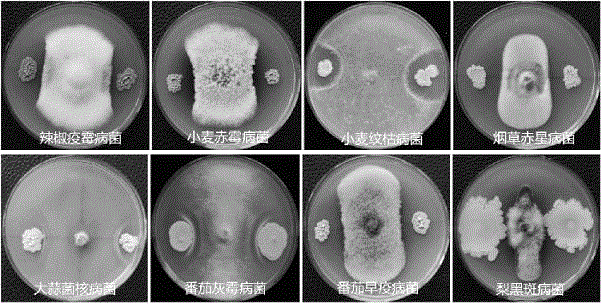Botrytis cinerea antagonistic strain and screening method and application thereof
A technology of Botrytis cinerea and screening method, which is applied in the field of microbial technology and biological control, and can solve problems such as environmental pollution
- Summary
- Abstract
- Description
- Claims
- Application Information
AI Technical Summary
Problems solved by technology
Method used
Image
Examples
Embodiment 1
[0034] Example 1 Isolation, Purification and Preservation of Bacteria in Soil
[0035] (1) 120 soils collected from Yunnan, Heilongjiang, Xinjiang, Hebei and other places were used to separate the soil by dilution plate method using PB medium. After culturing in the incubator at 28°C for 3 days, the colonies with different shapes were picked. Bacteria were streaked and purified five times, numbered, and stored in a -80°C refrigerator with 15% glycerol.
[0036](2) Use the plate confrontation method for primary screening of antagonistic bacteria. Use a puncher with a diameter of 5 mm to punch holes on the edge of the cucumber gray mold, inoculate the bacteria block in the center of the PDA plate, and pick 4 different single colonies evenly on the At a position 3cm away from the indicator bacteria, after culturing in the dark at 22°C for 5 days, the antibacterial effect was observed, and the strains with the antibacterial zone were selected for re-screening. 4,200 strains of ba...
Embodiment 2
[0038] Example 2 Identification of antagonistic bacteria BA-KA4
[0039] (1) Culture characteristics and morphological characteristics of antagonistic bacteria
[0040] The strain BA-KA4, as image 3 As shown, the growth on PB medium does not produce pigment, and the colonies are flat or round, milky white and opaque, with irregular edges and wrinkles on the surface. Gram-positive, microscopically observed as rod-shaped, producing spores, spores are oval or cylindrical.
[0041] (2) Physiological and biochemical characteristics of antagonistic bacteria
[0042] Refer to "Berjamin Bacterial Identification Manual" and "Common Bacterial System Identification Manual": V-P test positive, methyl red test negative, indole test positive, gelatin liquefaction test positive, citrate utilization test positive, starch hydrolysis test positive , lipase negative, H 2 S production test positive, nitrate reduction test positive, malonate utilization negative, tyrosine hydrolysis negative, ...
Embodiment 3
[0049] Example 3 Pot control effect test of Bacillus amyloliquefaciens BA-KA4 on cucumber gray mold
[0050] To prepare a seed bottle, pick a single colony of BA-KA4 and inoculate it into a 100 mL Erlenmeyer flask filled with 20 mL of PB liquid medium, and culture it on a shaker at 28°C and 180 rpm for 24 hours. Draw 10 mL of the bacterial solution from the seed bottle and inoculate it into a 500 mL Erlenmeyer flask containing 200 mL of PB liquid medium. After 48 hours of shaking culture at 28 ° C and 180 rpm on a shaking table, dilute it with sterile water to 1 × 10 8 CFU / mL is the bacterial suspension. Take the same concentration of bacterial suspension and sterilize at 121°C for 20 minutes, which is the sterile fermentation broth. Azoxystrobin was diluted 1000 times with sterile water. Use a hole puncher to punch holes on the edge of Botrytis cinerea growing for 3 days, put the bacteria block into 0.9% normal saline, 22°C, 180rpm shaker shaker for 30min, dilute with steri...
PUM
 Login to View More
Login to View More Abstract
Description
Claims
Application Information
 Login to View More
Login to View More - R&D
- Intellectual Property
- Life Sciences
- Materials
- Tech Scout
- Unparalleled Data Quality
- Higher Quality Content
- 60% Fewer Hallucinations
Browse by: Latest US Patents, China's latest patents, Technical Efficacy Thesaurus, Application Domain, Technology Topic, Popular Technical Reports.
© 2025 PatSnap. All rights reserved.Legal|Privacy policy|Modern Slavery Act Transparency Statement|Sitemap|About US| Contact US: help@patsnap.com



